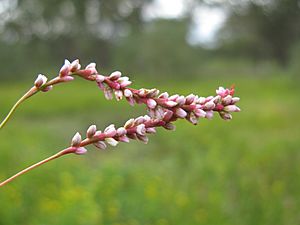Slender knotweed facts for kids
Persicaria decipiens, commonly known as slender knotweed, is a pretty flowering plant. It grows naturally in Australia and many parts of Asia. This plant is known for its long, thin stems and delicate pink flowers.
Quick facts for kids Slender knotweed |
|
|---|---|
 |
|
| Scientific classification | |
| Genus: |
Persicaria
|
| Species: |
decipiens
|
| Synonyms | |
|
List
|
|
Contents
About Slender Knotweed
What It Looks Like
Slender knotweed starts by growing stems that spread out along the ground. Over time, these stems grow more upright, reaching about 30 centimeters (1 foot) tall.
Its leaves are long and narrow, shaped like a spear. They are usually 5 to 12 centimeters (2 to 5 inches) long and about 0.5 to 1.3 centimeters (0.2 to 0.5 inches) wide.
The plant produces thin, pink flower spikes. These flowers usually appear from November to June, with the most flowers blooming in February. The flower spikes are shaped like cylinders and are not stiff, so they often bend over. In winter, the plant tends to die back, but it grows back when it gets water.
Where It Grows
You can find Persicaria decipiens in wet places, like near water or in very wet soil. It grows across Africa, the Mediterranean region, and through southwestern Asia. It is also found in Malesia and all states of Australia. You can even spot it on Norfolk Island, in New Zealand, and New Caledonia. It has also started growing naturally in Madagascar.
How It Reproduces
Insects are the likely helpers for this plant's reproduction. They carry pollen from one flower to another. These insects include honeybees, native bees, flies, wasps, and small butterflies.
Its History
Persicaria decipiens was one of the many plants collected by famous explorers Joseph Banks and Daniel Solander. They found it on May 5, 1770, at Botany Bay during Captain James Cook's first big sea journey.
Later, in 1810, a Scottish botanist named Robert Brown officially described this plant. He gave it the name Polygonum decipiens. This was part of his important book about the plants of Australia, called Prodromus Florae Novae Hollandiae et Insulae Van Diemen.
The plant got its current name, Persicaria decipiens, in 1988. This happened when the large group of plants called Polygonum was split into smaller, more specific groups by a scientist named Karen Wilson.
People also call this plant by other common names, such as willow weed and snake root.
Uses of the Plant
Persicaria decipiens is not usually grown in gardens or farms. However, in some parts of Africa, people have eaten it during times when food was scarce.


